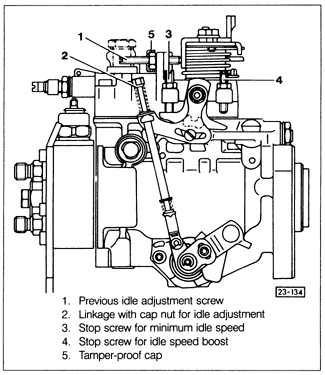Checking and Adjusting Idle Speed (1986 and later models with idle speed boost)Diesels since 1986 employ an injection pump with an idle speed boost system, as shown in Fig. 5-3, allowing manual idle boost for cold running. The old idle speed adjustment is sealed, and the cold start handle now has two detents. The first detent boosts the idle speed by about 60 rpm without cold start timing advance. The second detent increases idle by about 200 rpm and advances injection timing.

To measure idle, the engine should be at normal operating temperature. Oil temperature should be 140°F (60°C) minimum, or the cooling fan should have cycled on and off at least once. The cold start handle should not be pulled out, and all electrical accessories should be shut off. Engine speed on all 1986 and later diesels and turbo diesels should be 850 ± 30 rpm. To adjust, turn the cap nut on the adjusting linkage as shown in Fig. 5-3. Turn the nut clockwise to increase idle speed and counterclockwise to decrease idle speed. Finally, check the accelerator cable adjustment as described in 5.2 Accelerator Cable. The basic pump adjustments performed by the manufacturer should allow idle to be adjusted within specifications. If, however, the idle speed cannot be brought below 900 rpm, the linkage must be adjusted. First, loosen the locknut on the stop screw (number 3 shown in Fig. 5-3) and turn it two turns counterclockwise. Next, turn the cap nut on the linkage counterclockwise to adjust idle. Finally, turn the stop screw clockwise until it just touches the low idle stop and tighten the locknut. Quick-check idle speed boost with the engine running. With the cold start handle at the first detent, idle speed should increase to 910 ± 30 rpm. With the handle at the second detent, idle speed should be 1050 ± 50 rpm. If not correct, first check the adjustment of the cold start cable as described in 5.3 Cold Start System. To adjust, loosen the locknut on the stop screw (Fig. 5-3) and adjust idle by turning the stop screw. Tighten the locknut. The idle speed adjustment screw (Fig. 5-3) is not used to adjust idle speed, but instead to control residual pump volume. The screw is adjusted at the factory and covered by a tamper proof cap. Adjustment should not be required. Incorrect adjustment will result in high residual volume (screw turned in-high engine speed, idle speed adjustment not possible) or low residual volume (screw turned out-long cranking time, delayed acceleration from low rpm or jerking in all gears). Do not adjust the idle speed adjustment screw unless symptoms of high or low residual volume are exhibited and can not be corrected by any other method. If adjustments are necessary, remove the tamper proof cap from the idle speed adjustment screw and loosen the locknut. If residual volume is too high, first turn the screw out until engine speed stops decreasing. Then turn the screw in just until engine speed increases, and back the screw out 1/2 turn. If residual volume is too low, turn the screw in just until engine speed increases, then back the screw out 1/2 turn. When adjustment is correct, tighten the locknut and install a new tamper proof cap. |